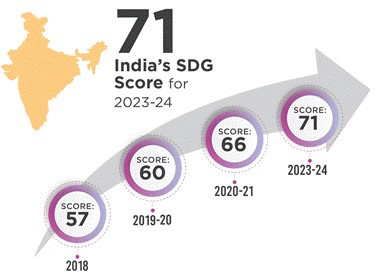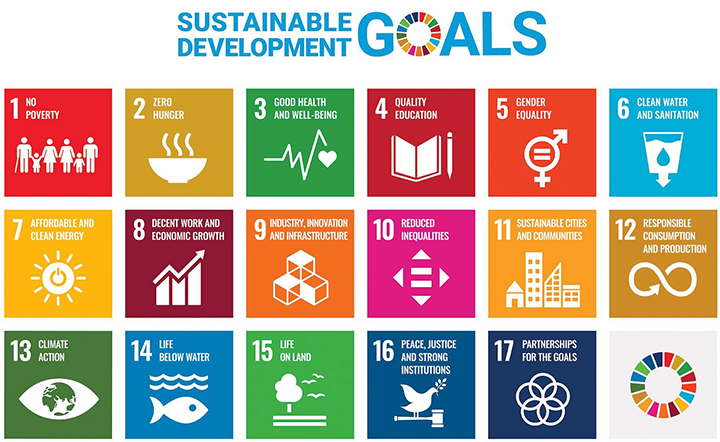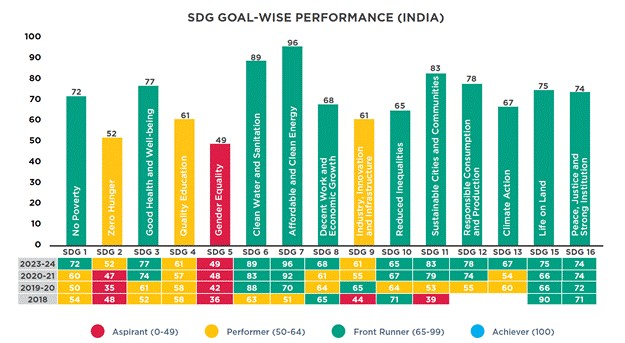Governance
NITI Aayog SDG India Index 2023-24
- 15 Jul 2024
- 14 min read
For Prelims: NITI Aayog, Sustainable Development Goal, United Nations, SDG India Index, Ujjwala Yojana, Pradhan Mantri Awas Yojana, Jal Jeevan Mission, Direct Benefit Transfer, Renewable Energy, Skill India Mission, PM Mudra Yojana
For Mains: Sustainable Development Goals, Government Initiatives, India's approach to the Sustainable Development Goals
Why in News?
The NITI (National Institution for Transforming India) Aayog has released its latest Sustainable Development Goal (SDG) India Index for 2023-24, showing significant progress in sustainable development across states and union territory of India.
What is the SDG India Index?
- About: The SDG India Index is a tool developed by NITI Aayog to measure and track India’s progress towards the SDGs set by the United Nations.
- The Index supports the localization of SDGs, encouraging states to integrate these goals into their development plans.
- It serves as a benchmark for policymakers to identify gaps and prioritise actions towards achieving sustainable development by 2030.
- Methodology: The Index assesses the performance of states and union territories (UTs) across 16 SDGs using a set of indicators aligned with national priorities.
- The SDG India Index measures national progress using 113 indicators aligned to the National Indicator Framework.
- Goal-wise scores are computed for the 16 SDGs, and overall composite scores are derived for each State/UT. Goal 14 (Life Below Water) has not been included in the calculation of the Composite Score for the Index as it solely pertains to the nine coastal States.
- Scores range from 0-100, with higher scores indicating greater progress toward SDG targets.
- State/UTs are categorised based on their SDG India Index score as follows: Aspirant: 0–49, Performer: 50–64, Front-Runner: 65–99, and Achiever: 100.
- Impact on Development: The Index promotes competitive and cooperative federalism, encouraging States and UTs to learn from each other and close outcome-based gaps.
- It provides a comprehensive analysis of progress, highlighting achievements and areas needing improvement.
- India fully integrated the SDGs into its national development strategies and is proud of its SDG localisation model based on institutional ownership, collaborative competition, capacity building, and a whole-of-society approach.
- The Index serves as a barometer for measuring progress towards Viksit Bharat @ 2047 and informs national and subnational development strategies.
What are the Key Highlights of the SDG India Index for 2023-24?
- Overall Progress: India's overall SDG score improved to 71 in 2023-24 from 66 in 2020-21 and 57 in 2018. All states have shown improvement in overall scores. Progress has been largely driven by targeted government interventions in poverty reduction, economic growth, and climate action.
- Top Performers: Kerala and Uttarakhand emerged as the best-performing states, each scoring 79 points.
- Lowest Performer: Bihar lagged behind with a score of 57 points, followed by Jharkhand at 62 points.
- Front-Runner States: 32 states and union territories (UTs) are in the front-runner category, with 10 new entrants including Arunachal Pradesh, Assam, Chhattisgarh, and Uttar Pradesh.

-
Government Interventions Contributions to SDG Progress:
-
Pradhan Mantri Awas Yojana: Over 4 crore houses built.
-
Swachh Bharat Mission: 11 crore toilets and 2.23 lakh community sanitary complexes constructed.
-
Ujjwala Yojana: 10 crore LPG connections provided.
-
Jal Jeevan Mission: Tap water connections in over 14.9 crore households.
-
Ayushman Bharat-PMJAY: Over 30 crore beneficiaries. Access to 150,000
-
Ayushman Arogya Mandir which offer primary medical care and provide affordable generic medicines.
-
PM Mudra Yojana: 43 crore loans sanctioned.
-
Saubhagya Scheme: 100% household electrification.
-
Renewable Energy: Solar power capacity increased from 2.82 GW to 73.32 GW in a decade.
-
National Food Security Act (NFSA): Coverage of over 80 crore people.
- Direct Benefit Transfer (DBT): Rs. 34 lakh crore made through PM-Jan Dhan accounts.
- Skill India Mission: Over 1.4 crore youth being trained and upskilled and has reskilled 54 lakh youth.
-
-
Specific SDGs:
| SDG | Key Highlights |
| Goal 1: No Poverty |
|
| Goal 2: Zero Hunger |
|
|
Goal 3: Good Health and Well-being |
|
| Goal 4: Quality Education |
|
| Goal 5: Gender Equality |
|
|
Goal 6: Clean Water and Sanitation |
|
| Goal 7: Affordable and Clean Energy |
|
| Goal 8: Decent Work and Economic Growth |
|
| Goal 9: Industry, Innovation and Infrastructure |
|
| Goal 10: Reduced Inequalities |
|
| Goal 11: Sustainable Cities and Communities |
|
| Goal 12: Responsible Consumption and Production |
|
|
Goal 13: Climate Action |
|
|
Goal 14: Life Below Water |
|
| Goal 15: Life on Land |
|
| Goal 16: Peace, Justice and Strong Institutions |
|
- Overview of the Goals: The goals "No Poverty", "Decent Work and Economic Growth", and "Life on Land" showed the highest increase in points across states from 2020-21 scores, while "Gender Equality" and "Peace, Justice, and Strong Institution" had the smallest increase.
- "Reduced Inequalities" was the only goal to decrease in points from 67 in 2020-21 to 65 in 2023-24. This reduction reflects the distribution of wealth and suggests that in many parts of India, there are high levels of inequality, particularly in relation to employment opportunities at the lower end of the socioeconomic spectrum. The goal of reducing inequalities also includes addressing gender inequality in workforce participation.
- Gender Equality received the lowest score among all goals, with a marginal increase from the previous year. Issues such as sex ratio at birth, women owning land and assets, employment, and labour force participation rate are areas of concern, particularly in states with below 900 sex ratio at birth.
- The Quality of Education goal increased by 4 points to 61, highlighting that some states, particularly in central India, still face challenges. The main issue in India is not access, but rather the quality of education, which impacts employment opportunities.

NITI Aayog
- The Planning Commission in India was replaced by NITI Aayog in 2015, with a shift towards a 'Bottom-Up' approach and emphasis on cooperative federalism.
- The composition of NITI Aayog includes the Prime Minister as Chairperson, Chief Ministers of all states and Lt. Governors of Union Territories in the Governing Council, and experts nominated by the Prime Minister as Special Invitees.
- Chief Executive Officer appointed by the Prime Minister for a specific term, holding the rank of Secretary to the Government of India.
- The NITI Aayog recognises the need for a more flexible approach to economic planning in India, taking into account the diverse strengths and weaknesses of its states. This shift is necessary to make India competitive in the global economy.
- The key objectives are to promote cooperative federalism with states, develop plans at the village level, incorporate national security into economic strategy, focus on marginalised sections of society, encourage partnerships with stakeholders and think tanks, create a support system for knowledge and innovation, resolve inter-sectoral issues, and maintain a resource centre for good governance and sustainable development practices.
- Major Initiatives: SDG India Index, Composite Water Management Index, Atal Innovation Mission, Aspirational District Programme, Health Index, India Innovation Index, and Good Governance Index.
|
Drishti Mains Question: Q. Evaluate the overall progress of India towards achieving the Sustainable Development Goals as reflected in the SDG India Index 2023-24. What factors have contributed to this progress? |
UPSC Civil Services Examination, Previous Year Questions (PYQs)
Prelims
Q. Atal Innovation Mission is set up under the (2019)
(a) Department of Science and Technology
(b) Ministry of Labour and Employment
(c) NITI Aayog
(d) Ministry of Skill Development and Entrepreneurship
Ans: (c)
Q. The Government of India has established NITI Aayog to replace the (2015)
(a) Human Rights Commission
(b) Finance Commission
(c) Law Commission
(d) Planning Commission
Ans: (d)
Q. Sustainable development is described as the development that meets the needs of the present without compromising the ability of future generations to meet their own needs. In this perspective, inherently the concept of sustainable development is intertwined with which of the following concepts? (2010)
(a) Social justice and empowerment
(b) Inclusive Growth
(c) Globalization
(d) Carrying capacity
Ans: (d)
Mains
Q. How are the principles followed by the NITI Aayog different from those followed by erstwhile Planning Commission in India? (2018)
Q. Access to affordable, reliable, sustainable and modern energy is the sine qua non to achieve Sustainable Development Goals (SDGs).” Comment on the progress made in India in this regard. (2018)





